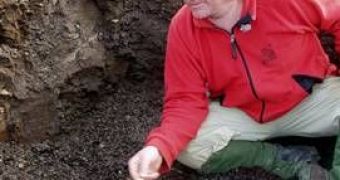A total of 28 plesiosaurs and ichthyosaurs, both top marine reptile predators dominating the seas when dinosaurs roamed on land, were found by Norwegian researchers at a site on the island of Spitsbergen (Svalbard), about 1,300 km from the North Pole. The fossils were dated 150 million years old, during the Jurassic era. "One of them was this gigantic monster, with vertebrae the size of dinner plates and teeth the size of cucumbers," said Joern Hurum, an assistant professor at the University of Oslo, about a huge pliosaur (image above), a kind of plesiosaur with short neck and massive skull, more adapted to deep diving than classical plesiosaurs, looking like a crocodile with turtle flippers.
Typical plesiosaurs (central image) were marine reptile with flipper like members, similar with tose found in current marine turtles, but with very long necks, quite similar to the monster from the stories about seasnake. They disappeared in the same event that led to the extinction of the dinosaurs.
"We believe the skeleton is intact and that it's about 10 meters long," Hurum told. "Such pliosaurs are known from remains in countries including Britain and Argentina but no complete skeleton has been found," he said.
The skull of the pliosaur is among the biggest on record. Next year, the team will try to excavate the entire fossil, buried on a hillside. Pliosaurs often preyed on smaller dolphin-like ichthyosaurs (image bellow). Ichthyosaurs went extinct before the pliosaurs, in Mid-Cretaceous era, 25 million years earlier than the dinosaurs.
The scientists rated the fossil graveyard "one of the most important new sites for marine reptiles to have been discovered in the last several decades."
"It is rare to find so many fossils in the same place, carcasses are food for other animals and usually get torn apart," Hurum said.
The reptiles have not died all at the same time in a cataclysm event, but over thousands of years in the same area, then became preserved in what was apparently a deep layer of black mud on the seabed. Meanwile, the teritory of Spitsbergen was a seabed several hundred miles farther south, around 60 degrees North (now they are situated at around 80 degrees North). Hurum warned that the fossils must trigger the attention of geologists looking for oil and gas deposits in the Barents Sea to the east. "A skull we found even smells of petrol," he said.
Photo credit: Natural History Museum, University of Oslo

 14 DAY TRIAL //
14 DAY TRIAL // 


